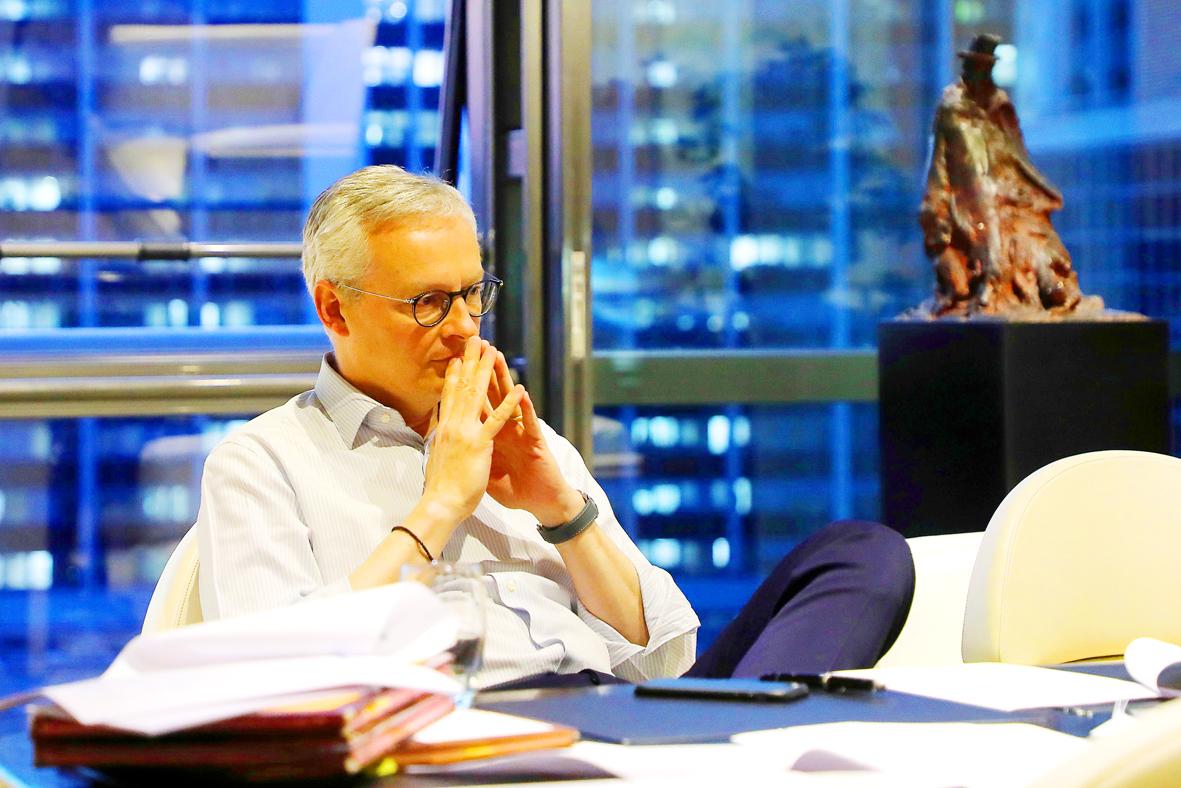EU finance ministers on Thursday agreed on a 540 billion euros (US$591 billion) package of measures to combat the economic fallout of the global COVID-19 pandemic. It is now up to EU leaders to approve the accord, which would require overcoming profound political disagreements.
In an emergency teleconference, the Eurogroup approved a plan to stave off what is expected to be a recession of unprecedented size.
The deal would lay to rest — at least temporarily — concerns that the EU was incapable of uniting behind a common strategy when it was most urgently needed.

Photo: AFP
In a sign of relief, ministers broke out in applause once a consensus was struck.
“Today, we agreed on three safety nets, and a plan for the recovery to ensure we grow together and not apart once the crisis is behind us,” said Portuguese Minister of Finance Mario Centeno, who heads the Eurogroup.
The common response includes a joint 100 billion euros employment insurance fund, a European Investment Bank instrument intended to supply 200 billion euros of liquidity to companies, as well as credit lines of as much as 240 billion euros from the European Stability Mechanism — the eurozone’s bailout fund — to backstop states as they go on a spending spree to help get economies back on their feet.
The ministers also agreed to work on a temporary fund that would help kick-start the recovery and support the hardest-hit nations, while not defining how it would be financed.
French Minister of the Economy and Finance Bruno Le Maire said the fund could be decided on in the next six months and could total 500 billion euros.
All of it needs approval by EU government leaders as early as next week, and tensions persist.
With several key divisions papered over, disagreements are likely to resurface when leaders are called to sign off.
The COVID-19 pandemic has overwhelmed Europe, with the continent suffering more than 65 percent of the worldwide deaths attributable to the coronavirus.
The scale of the damage shines a spotlight on the vulnerabilities of a union whose sense of common purpose has been tested over the past decade by the Greek debt crisis, an influx of refugees and Brexit, but the pandemic — in the words of German Chancellor Angela Merkel, a veteran of many geopolitical fights — poses the biggest threat to the EU since World War II.
Europe’s more-frugal north is pitted against Italy and Spain, the worst-affected nations, in a climate of mistrust and simmering resentment.
Disagreements were laid bare earlier this week when finance ministers failed to agree on a joint response after 16 hours of bitter negotiations.
Things were different on Thursday.
The meeting was delayed by nearly five hours while key nations — including the Netherlands, Italy, France, Germany and Spain — negotiated a compromise that would ultimately be uncomfortable to most, yet acceptable to all.
Once the meeting started, it took just 30 minutes to declare success.

Shares in Taiwan closed at a new high yesterday, the first trading day of the new year, as contract chipmaker Taiwan Semiconductor Manufacturing Co (TSMC, 台積電) continued to break records amid an artificial intelligence (AI) boom, dealers said. The TAIEX closed up 386.21 points, or 1.33 percent, at 29,349.81, with turnover totaling NT$648.844 billion (US$20.65 billion). “Judging from a stronger Taiwan dollar against the US dollar, I think foreign institutional investors returned from the holidays and brought funds into the local market,” Concord Securities Co (康和證券) analyst Kerry Huang (黃志祺) said. “Foreign investors just rebuilt their positions with TSMC as their top target,

REVENUE PERFORMANCE: Cloud and network products, and electronic components saw strong increases, while smart consumer electronics and computing products fell Hon Hai Precision Industry Co (鴻海精密) yesterday posted 26.51 percent quarterly growth in revenue for last quarter to NT$2.6 trillion (US$82.44 billion), the strongest on record for the period and above expectations, but the company forecast a slight revenue dip this quarter due to seasonal factors. On an annual basis, revenue last quarter grew 22.07 percent, the company said. Analysts on average estimated about NT$2.4 trillion increase. Hon Hai, which assembles servers for Nvidia Corp and iPhones for Apple Inc, is expanding its capacity in the US, adding artificial intelligence (AI) server production in Wisconsin and Texas, where it operates established campuses. This

H200 CHIPS: A source said that Nvidia has asked the Taiwanese company to begin production of additional chips and work is expected to start in the second quarter Nvidia Corp is scrambling to meet demand for its H200 artificial intelligence (AI) chips from Chinese technology companies and has approached contract manufacturer Taiwan Semiconductor Manufacturing Co (TSMC, 台積電) to ramp up production, sources said. Chinese technology companies have placed orders for more than 2 million H200 chips for this year, while Nvidia holds just 700,000 units in stock, two of the people said. The exact additional volume Nvidia intends to order from TSMC remains unclear, they said. A third source said that Nvidia has asked TSMC to begin production of the additional chips and work is expected to start in the second

US President Donald Trump on Friday blocked US photonics firm HieFo Corp’s US$3 million acquisition of assets in New Jersey-based aerospace and defense specialist Emcore Corp, citing national security and China-related concerns. In an order released by the White House, Trump said HieFo was “controlled by a citizen of the People’s Republic of China” and that its 2024 acquisition of Emcore’s businesses led the US president to believe that it might “take action that threatens to impair the national security of the United States.” The order did not name the person or detail Trump’s concerns. “The Transaction is hereby prohibited,”